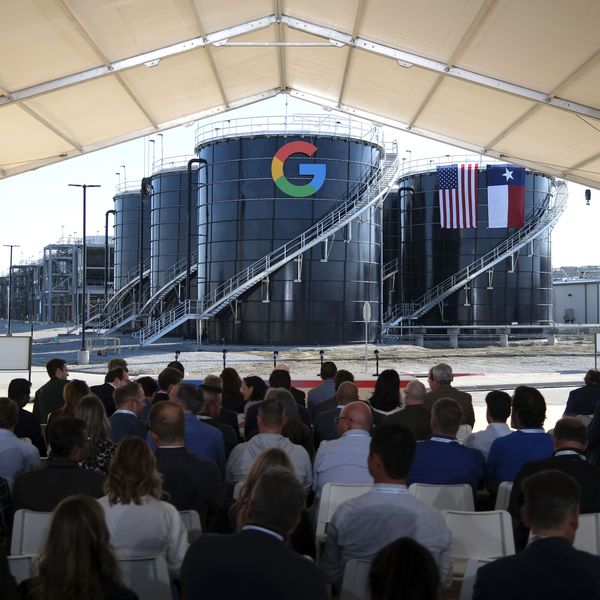Google Invests in $5bn Wind-Power Superhighway
The Atlantic Wind Connection Project will serve 1.9m homes from New Jersey to Virginia with electricity from dozens of offshore windfarms
Google is extending its investment in green technology with a $5bn (PS3.2bn) programme to build an undersea, wind energy transmission backbone along 350 miles of the Atlantic seaboard.
The
grid project, which stands to serve 1.9m homes from Virginia to New
Jersey with up to 6,000 megawatts of electric power from dozens of
windfarms 10 miles off the mid-Atlantic coast, is the most ambitious of
its kind.
Google announced it is working with Trans-Elect and two
other firms, but has not offered a timetable for construction. "This
system will act as a superhighway for clean energy," said Rick Needham,
Google's green-business operations director.
Investment in both
wind energy programmes and the controversial extraction of shale oil
from deposits in North Dakota, Montana and Alberta, Canada, has
increased since the BP spill over the summer caused US lawmakers to curb
permits for offshore oil and gas drilling.
For Google, the
Atlantic Wind Connection Project is in line with earlier investments. In
May, it put $40m into two North Dakota windfarms, its first
clean-energy investment. Two days ago the firm announced it had tested a self-driving electric car on Californian highways.
Today's
announcement offers hope that further investment will pour into the
lagging US wind-energy programme. Consistent wind through Montana and
the Dakotas, off the South Carolina coast and across the Texas panhandle
gives the US windfarm industry an opportunity to supply significant
amounts of electricity to the grid.
But compared with China, now
the leading manufacturer of wind turbines and solar energy equipment,
the US had been comparatively slow in adopting the technology. Public
opposition to windfarms, including a large project off the presidential
holiday island of Martha's Vineyard, has taken years to resolve.
That
may now be changing: the Global Wind Energy Council industry group
estimates wind-power investment may reach $202bn over the next 20 years.
Charlie
Hodges, a wind industry analyst at Bloomberg New Energy Finance, said:
"The North American wind industry hasn't had any players involved with
the motivation and financial heft to really move this market forward.
Google could play that role."
An Urgent Message From Our Co-Founder
Dear Common Dreams reader, The U.S. is on a fast track to authoritarianism like nothing I've ever seen. Meanwhile, corporate news outlets are utterly capitulating to Trump, twisting their coverage to avoid drawing his ire while lining up to stuff cash in his pockets. That's why I believe that Common Dreams is doing the best and most consequential reporting that we've ever done. Our small but mighty team is a progressive reporting powerhouse, covering the news every day that the corporate media never will. Our mission has always been simple: To inform. To inspire. And to ignite change for the common good. Now here's the key piece that I want all our readers to understand: None of this would be possible without your financial support. That's not just some fundraising cliche. It's the absolute and literal truth. We don't accept corporate advertising and never will. We don't have a paywall because we don't think people should be blocked from critical news based on their ability to pay. Everything we do is funded by the donations of readers like you. Will you donate now to help power the nonprofit, independent reporting of Common Dreams? Thank you for being a vital member of our community. Together, we can keep independent journalism alive when it’s needed most. - Craig Brown, Co-founder |
Google is extending its investment in green technology with a $5bn (PS3.2bn) programme to build an undersea, wind energy transmission backbone along 350 miles of the Atlantic seaboard.
The
grid project, which stands to serve 1.9m homes from Virginia to New
Jersey with up to 6,000 megawatts of electric power from dozens of
windfarms 10 miles off the mid-Atlantic coast, is the most ambitious of
its kind.
Google announced it is working with Trans-Elect and two
other firms, but has not offered a timetable for construction. "This
system will act as a superhighway for clean energy," said Rick Needham,
Google's green-business operations director.
Investment in both
wind energy programmes and the controversial extraction of shale oil
from deposits in North Dakota, Montana and Alberta, Canada, has
increased since the BP spill over the summer caused US lawmakers to curb
permits for offshore oil and gas drilling.
For Google, the
Atlantic Wind Connection Project is in line with earlier investments. In
May, it put $40m into two North Dakota windfarms, its first
clean-energy investment. Two days ago the firm announced it had tested a self-driving electric car on Californian highways.
Today's
announcement offers hope that further investment will pour into the
lagging US wind-energy programme. Consistent wind through Montana and
the Dakotas, off the South Carolina coast and across the Texas panhandle
gives the US windfarm industry an opportunity to supply significant
amounts of electricity to the grid.
But compared with China, now
the leading manufacturer of wind turbines and solar energy equipment,
the US had been comparatively slow in adopting the technology. Public
opposition to windfarms, including a large project off the presidential
holiday island of Martha's Vineyard, has taken years to resolve.
That
may now be changing: the Global Wind Energy Council industry group
estimates wind-power investment may reach $202bn over the next 20 years.
Charlie
Hodges, a wind industry analyst at Bloomberg New Energy Finance, said:
"The North American wind industry hasn't had any players involved with
the motivation and financial heft to really move this market forward.
Google could play that role."
Google is extending its investment in green technology with a $5bn (PS3.2bn) programme to build an undersea, wind energy transmission backbone along 350 miles of the Atlantic seaboard.
The
grid project, which stands to serve 1.9m homes from Virginia to New
Jersey with up to 6,000 megawatts of electric power from dozens of
windfarms 10 miles off the mid-Atlantic coast, is the most ambitious of
its kind.
Google announced it is working with Trans-Elect and two
other firms, but has not offered a timetable for construction. "This
system will act as a superhighway for clean energy," said Rick Needham,
Google's green-business operations director.
Investment in both
wind energy programmes and the controversial extraction of shale oil
from deposits in North Dakota, Montana and Alberta, Canada, has
increased since the BP spill over the summer caused US lawmakers to curb
permits for offshore oil and gas drilling.
For Google, the
Atlantic Wind Connection Project is in line with earlier investments. In
May, it put $40m into two North Dakota windfarms, its first
clean-energy investment. Two days ago the firm announced it had tested a self-driving electric car on Californian highways.
Today's
announcement offers hope that further investment will pour into the
lagging US wind-energy programme. Consistent wind through Montana and
the Dakotas, off the South Carolina coast and across the Texas panhandle
gives the US windfarm industry an opportunity to supply significant
amounts of electricity to the grid.
But compared with China, now
the leading manufacturer of wind turbines and solar energy equipment,
the US had been comparatively slow in adopting the technology. Public
opposition to windfarms, including a large project off the presidential
holiday island of Martha's Vineyard, has taken years to resolve.
That
may now be changing: the Global Wind Energy Council industry group
estimates wind-power investment may reach $202bn over the next 20 years.
Charlie
Hodges, a wind industry analyst at Bloomberg New Energy Finance, said:
"The North American wind industry hasn't had any players involved with
the motivation and financial heft to really move this market forward.
Google could play that role."

